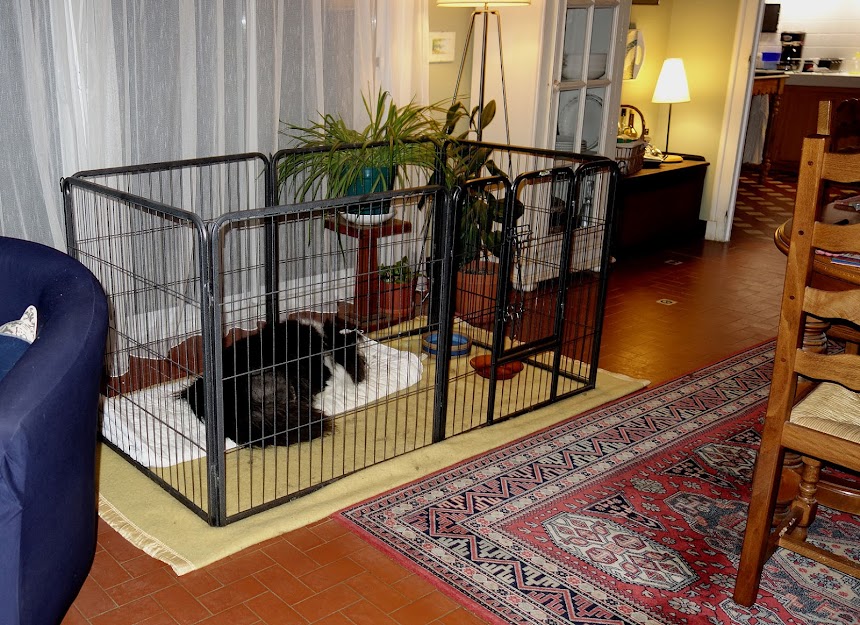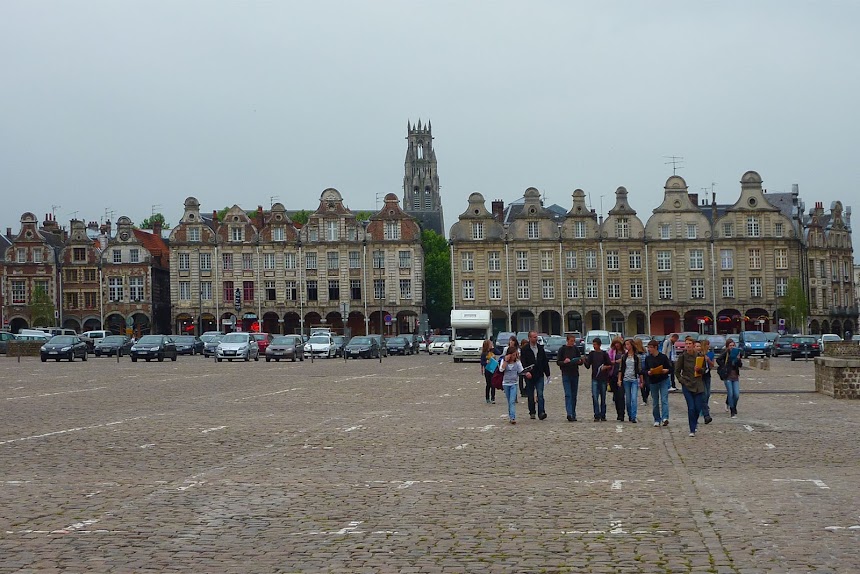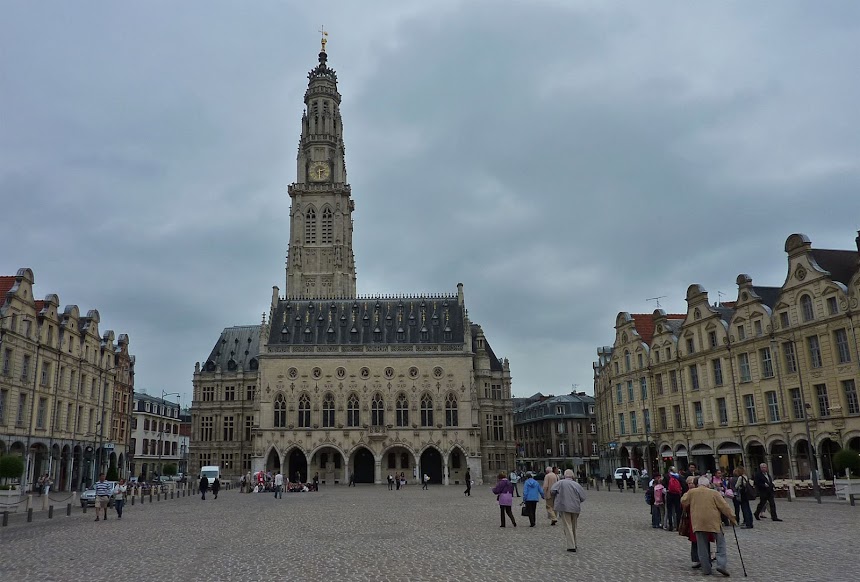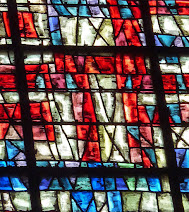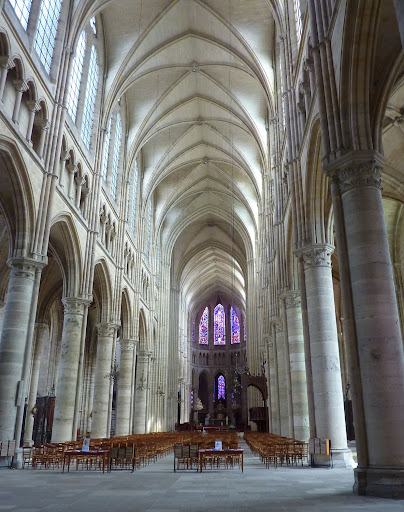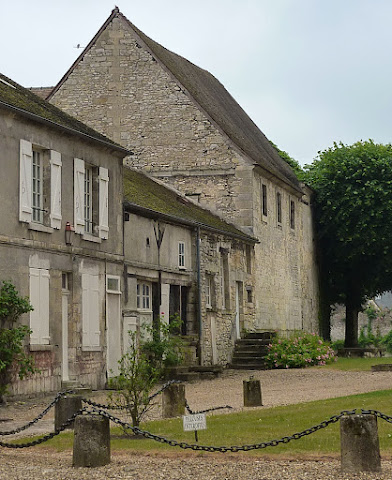The current church that serves as the cathedral in Cambrai was not built for that purpose. The Gothis-style building that used to be the cathedral there was built over the course about a century starting in the year 1180. It ended up being demolished 600 years later during the French Revolution. This Classical style, late 17th century church was chosen to replace it. It made it through the Revolution basically unscathed.
Here is an artist's rendering of the Gothic cathedral that used to be in Cambrai. I found the image on Wikipédia and other web pages. It's in the public domain, because the artist who painted it died 70 years ago. The old cathedral suffered severe damage during the Revolution and afterwards was sold to a man who used it as a quarry and sold off the stones it was built of.
This last photo is a slightly longer shot of the top of the bell toward at today's cathedral. The original tower was built in the 16th century, but had to be torn down in 1791 because it was feared that years of neglect had made it dangerous. Today's bell tower dates back only to 1876. It rises to a height of 65 meters (213 ft). It was hit by a mortar shell during World War I that left a big hole in one wall, but it didn't come crashing down.
28 February 2022
27 February 2022
26 February 2022
Cabin fever, and an apple pancake
This morning, I realized that I've got cabin fever. That's a malady you get when you spend too much time shut up inside your house. And I've got it despite the fact that I take Tasha out for a (short) walk every day. Walt does the same. Tasha needs the exercise and fresh air. Maybe I need to go out in the car and take a long drive. And take my camera with me. There's a town 15 minutes from here called Villentrois where I'd like to take some photos. There's a town about an hour away called Brinay where I'd like to go take pictures too. The afternoons are sunny right now.
Above is a photo of Tasha sleeping in her "doggy corral" (enclos pour chien) in the living room. She sleeps in there every morning for two or three hours while I work on my laptop nearby. At night we carry her upstairs — she can walk, but not on stairs yet — to the loft and put her in a second enclos, where she spends the night. I think she's comfortable, and she took to the corrals immediately. She's been spending 90 to 95 per cent of her time in them for about a month now. She's doing a lot better, but who knows if she will ever entirely recover and have full mobility again. She's 5 years old now, and this accident ended her puppyhood rather brutally.
Meanwhile, yesterday afternoon I made an apple pancake called a crépiau or crêpiot that I read about and mentioned a few days ago in comments. It's a little like a clafoutis that's cooked in a pan on top of the stove instead of in the oven. Three cored, peeled, and sliced apples are cooked in some butter in a frying pan, and then an egg, flour, and milk batter is poured over them to cook. Actually, it might have been better to make two smaller crépiaux instead of one big one. I couldn't figure out how I was going to turn it over to brown it on both sides, so finally I browned the top under the broiler in the oven. The batter is a variation on crêpe batter, and I made this one using one-third buckwheat flour (sarrasin or farine de blé noir) and two-thirds plain wheat flour. Here's the recipe.
Crépiau (Crêpiot, Crapiau)
An unleavened French apple pancake
2 eggs
250 g flour (2 cups)
1 Tbsp. sugar (or more)
500 ml milk (2 cups)
3 apples
40 g butter, divided (4 tablespoons)
Optional: a small amount of vanilla extract, rum, or calvados, to taste
250 g flour (2 cups)
1 Tbsp. sugar (or more)
500 ml milk (2 cups)
3 apples
40 g butter, divided (4 tablespoons)
Optional: a small amount of vanilla extract, rum, or calvados, to taste
Mix the egg with the flour. Dilute with the milk. Melt half the butter and mix it into the batter.
Optionally, you can add some sugar to the batter, which should rest for 45 minutes or longer.
Optionally, you can add some sugar to the batter, which should rest for 45 minutes or longer.
Peel and core the apples. Cut them into thin slices. Put them in a large frying pan
with the rest of the butter and cook on medium heat.
with the rest of the butter and cook on medium heat.
Once the apples have softened, turn the heat down to low and pour the batter
over them. Let the pancake cook for about 15 minutes covered.
over them. Let the pancake cook for about 15 minutes covered.
When the pancake has set, turn it over to brown the other side.
(I browned the top under the broiler in our toaster oven.)
(I browned the top under the broiler in our toaster oven.)
Serve warm or cold in wedges or squares.
25 February 2022
Arras: cats and a belfry
The bell tower or belfry (le beffroi in French) in Arras is listed as part of the UNESCO world heritage site Belfries of Belgium and France. There are 56 belfries in the Flanders region of Belgium and in French Flanders (la Flandre Française) in France. The bells in belfries are (or were) rung to alert the local population to imminent danger.

 The belfry in Arras was built in the 14th and 15th centuries. It had to be rebuilt in the 1830s, after decades of neglect,
The belfry in Arras was built in the 14th and 15th centuries. It had to be rebuilt in the 1830s, after decades of neglect,and again in the 1920s, after the Great War of 1914-1918, each time à l'identique. It stands 75 meters (250 ft) tall.
Just a few days ago, my blogger friend Susan at Days on the Claise published an informative post about belfries and sirens.

 The belfry in Arras is topped off by a gilded lion. I'm not sure how I got a decent close-up photo of it from ground level.
The belfry in Arras is topped off by a gilded lion. I'm not sure how I got a decent close-up photo of it from ground level.The big cat was looking down as these two house cats were keeping watch over the city the day I was there in 2011.
24 February 2022
C'est Arras, en Flandre
The city I posted about yesterday is Arras (pop. 42,000) in French Flanders. Arras was nearly wiped off the map (75% destroyed) during World War I but, like so many French cities, it was rebuilt à l'identique after the war. The city didn't suffer as much during World War II. Below are some photos of buildings and shops around one of the city's two expansive places publiques (plazas, squares) in the Baroque style.
The French Wikipédia article about Arras says: Arras est réputée pour ses deux magnifiques places baroques qui forment un ensemble architectural unique au monde, son beffroi et sa Citadelle, tous deux classés au patrimoine mondial de l'UNESCO. Avec 225 édifices protégés au titre des monuments historiques, Arras est la ville avec la densité de monuments la plus importante de France.
___________________________________________________________________________________
We took delivery of our new refrigerator late yesterday afternoon, pretty much exactly a week after the old one broke down. It was only 6½ years old, but since we paid about 650 euros for it in 2015, it only cost us 100 euros a year. Except for the scramble we've live through for a week now, that's not too bad.
The new fridge is a frost-free Samsung model.
23 February 2022
An excursion into Flanders

One of the things I did when CHM and I drove up to Picardy north of Paris in June 2011 was to take a day trip up into French Flanders (la Flandre française) on my own to see a couple of small cities that I'd always heard of but never before seen. This is one of them. It's about 50 miles from the Channel coast, 80 miles from Brussels, and 100 miles north of Paris. Maybe you recognize it...
22 February 2022
Le Tortoir, un ancien prieuré dans l'Aisne
Le Tortoir, out in the country about 15 miles north of Soissons, is a 14th century fortified Catholic priory
(a religious community — more or less a small abbey, convent, or monastery). It was a dependency of
a nearby abbey that had been founded several centuries earlier by Philippe 1er, who was king
of the Franks for 48 years (1060-1108). Only ruins of that abbey remain today.
a nearby abbey that had been founded several centuries earlier by Philippe 1er, who was king
of the Franks for 48 years (1060-1108). Only ruins of that abbey remain today.
1 
 2
2
Le Tortoir is a small compound made up of a residential building, a chapel, and a big mysterious barn of a building.
The property is closed in by buildings on two sides and walls on the two other sides — here's an aerial view.
It's not open to the public (il ne se visite pas). Nowadays it's privately owned. CHM and I stopped there
to take photos after spending a few hours in Soissons in June 2011.

 2
2Le Tortoir is a small compound made up of a residential building, a chapel, and a big mysterious barn of a building.
The property is closed in by buildings on two sides and walls on the two other sides — here's an aerial view.
It's not open to the public (il ne se visite pas). Nowadays it's privately owned. CHM and I stopped there
to take photos after spending a few hours in Soissons in June 2011.
 3
3This is a large-format composite image I created by stitching together two separate photos.
The building on the right in this image is the one you see in photos #4 and #5 below.
4 
 5
5
Nobody knows what the large barn of a building at Le Tortoir was used for. It might have housed a leper colony,
or it might have been a refectory and dormitory for guests visiting the priory. It was probably built early in
the 14th century. It measures 28 meters (92 ft) by 10 meters (32 ft). At the time of the French Revolution,
when properties owned by the clergy were privatized, Le Tortoir was sold to a farming family who lived
there for about 100 years. In 1925, after the priory complex was bought by a Belgian company,
the big old barn was used as stables. The windows were filled in to reinforce the structure.
All this detailed but sketchy information is in the French Wikipédia article about Le Tortoir.

 5
5Nobody knows what the large barn of a building at Le Tortoir was used for. It might have housed a leper colony,
or it might have been a refectory and dormitory for guests visiting the priory. It was probably built early in
the 14th century. It measures 28 meters (92 ft) by 10 meters (32 ft). At the time of the French Revolution,
when properties owned by the clergy were privatized, Le Tortoir was sold to a farming family who lived
there for about 100 years. In 1925, after the priory complex was bought by a Belgian company,
the big old barn was used as stables. The windows were filled in to reinforce the structure.
All this detailed but sketchy information is in the French Wikipédia article about Le Tortoir.
21 February 2022
La Galettière, une crêperie
When CHM and I were in Soissons that June day long ago, we had lunch in a restaurant before we went to take photos in the cathedral. The restaurant we chose was a crêperie that also served the savory (i.e. not sweet) crêpes that are called galettes in Brittany and, according to the dictionary, western France. Galettes are thin buckwheat pancakes that are filled with ham, cheese, mushrooms, etc. and often have an egg on top. Buckwheat is called sarrasin in French, so they are galettes de sarrasin. The word galette has many meanings, including what we call a cookie. Essentially, it's a flat, round cake or bread in this context.
 The word crêpe is related to the English word "crisp". They're very thin pancakes that are crispy and lacy around the edges. They are not leavened with baking powder the way American pancakes are. The galette above is what I had for lunch
The word crêpe is related to the English word "crisp". They're very thin pancakes that are crispy and lacy around the edges. They are not leavened with baking powder the way American pancakes are. The galette above is what I had for lunchin Soissons. It was served with mushrooms in a thick béchamel sauce, with an egg on top and with melted cheese.
I think I can see a slice of ham inside.
 The galette also came with a green salad on the side. French salad is often just leaf lettuce with a vinaigrette dressing
The galette also came with a green salad on the side. French salad is often just leaf lettuce with a vinaigrette dressingand some salt and pepper — unless it's a salade composée, which can beserved as a main course (plat principal).
The restaurant, La Galettière, bills itself not only as a crêperie, but also as a saladerie.

As we left the restaurant, I took this photo of our waiter, who was outside taking a cigarette break.
Here's a link to the Tripadvisor page about la Galettière, with many more photos.
20 February 2022
Croyant ou pas croyant ?
Isn't it ironic that in France, one of the most un-religious countries in the world these days, every town and village is centered on a church, and every city has dozens of them? The city of Tours — pop. approx. 140,000, area 13½ mi²) — there are more than 50 churches and chapels. I think most of them stand empty most of the time — even on Sundays. By the way, churches in France are publicly owned (by the national government or local governments), with the exception of those built after 1905, the year France officially declared the separation of church and state. An article I just read says there are 32,000 churches, 6,000 chapels, and 87 cathedrals in France.
Meanwhile, the Paris newspaper Le Figaro reported last September that according to a 2021 poll, 51% of the French people they interviewed said that that they personally don't believe in God. When asked whether the Covid-19 pandemic had made them more likely to practice a religion, 91% said no. Asked in 2021 if they ever discuss religion with family members, 58% said no, compared to 38% who said no to that question when polled in 2009.
19 February 2022
Soissons : vitraux
These are just a few of the photos of stained glass that I took in the cathedral at Soissons in 2011.
A stained-glass window is un vitrail [vee-TRAH-yuh] in French; the plural is vitraux [vee-TROH].
A stained-glass window is un vitrail [vee-TRAH-yuh] in French; the plural is vitraux [vee-TROH].
I applied a Photoshop "dry brush" effect on photo 1 and photo 7 because they were not as sharp as the others.
Here's a very detailed description of the church windows at the cathedral in Soissons.
Here's a very detailed description of the church windows at the cathedral in Soissons.
18 February 2022
Soissons : la cathédrale
When you first lay eyes on the cathedral at Soissons, you almost feel sorry for it. Where did its north tower go? Well, it never went anywhere. It was planned but never built. Construction of the building began in the 13th century and continued into the 14th. Then the Hundred Years' War intervened. Construction was halted.
This cathedral has suffered through many battles and wars, most notably the Great War of 1914-18. The town of Soissons was 80% destroyed during that war, and the cathedral was heavily damaged. The town was rebuilt; the cathedral was restored.
The interior of the cathedral stands in stark contrast to the exterior. The Michelin guidebook uses phrases like absolument symétrique in praising la beauté intérieure de l'édifice, calling it une merveille de grâce...
17 February 2022
Encore une panne
Another breakdown. Last night I noticed that our refrigerator was not as cold as it should be. There was a red warning light on the electronic control panel. Some bread we had in the freezer felt soft. We pushed a lot of buttons and the warning light went off. However, the fridge was still not working this morning. Luckily we had room for a lot of frozen things in the downstairs freezer. I also just summarily put a lot of stuff in the garbage. Now we have to figure out what we're going to do about getting a new fridge. This one is seven years old.
P.S. The man who might be able to repair the fridge is coming over tomorrow afternoon. He also sells appliances and has a model in stock that we are interested in. Tomorrow will be decision day — or not, if he says the old fridge can't be repaired or is not worth repairing. If that's what he says, we'll soon have a new fridge.
16 February 2022
Next stop, Soissons and a ruin
After spending an hour or two in Senlis on that Sunday morning in June 2011, we drove on east to the town of Soissons. The first place we stopped for a Kodak moment was at the ruins of an old abbey church called Saint-Jean-des-Vignes. The abbey was founded in the year 1076 and was one of the richest abbeys of the Middle Ages. The largesse of French kings, bishops, local lords, and bourgeois merchants financed the building of an imposing abbey church and sturdy monastic buildings on the site in the 13th and 14th centuries. That's what the Michelin Guide says.
1 
 2
2
Centuries later, in 1805, the emperor Napoleon and the bishop of Soissons signed an order to have the abbey church
torn down so that the materials it was built with could be used to repair the nearby cathedral in Soissons.
People protested, and the authorities agreed to leave the church's main façade standing.

 2
2Centuries later, in 1805, the emperor Napoleon and the bishop of Soissons signed an order to have the abbey church
torn down so that the materials it was built with could be used to repair the nearby cathedral in Soissons.
People protested, and the authorities agreed to leave the church's main façade standing.
15 February 2022
Senlis : le quartier ancien
These are some photos taken in what the Michelin green guidebook calls le quartier ancien around the cathedral in Senlis. By the way, the church was built nearly a thousand years as a cathedral, replacing a first cathedral that was already more that 500 years old. It was overseen by a bishop, and the town of Senlis (the final S is pronounced) had been a royal city where Frankish kings held court. However, the Senlis cathdral is no longer officially a cathedral, and the royalty moved away many centuries ago. Senlis had earlier been a Roman colony.
The town of Senlis (pop. 15,000) has a very informative web site where you can read more (in French) about the history of the city and the cathedral, including this panoramic view of the quartier ancien. This part of the town was within the walls of the old Gallo-Roman settlement. Senlis is just 30 or so miles north of Paris and only 10 miles north of CDG airport. As a bonus, the famous Château de Chantilly is only 5 miles to the west.
The town of Senlis (pop. 15,000) has a very informative web site where you can read more (in French) about the history of the city and the cathedral, including this panoramic view of the quartier ancien. This part of the town was within the walls of the old Gallo-Roman settlement. Senlis is just 30 or so miles north of Paris and only 10 miles north of CDG airport. As a bonus, the famous Château de Chantilly is only 5 miles to the west.
Subscribe to:
Posts (Atom)





